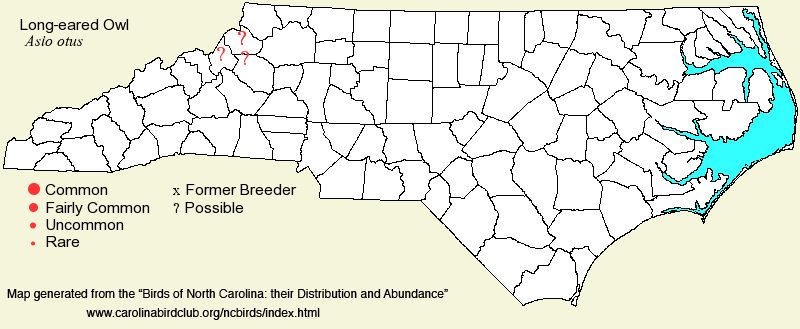 |  |
|
Long-eared Owl - Asio otus STRIGIDAE Members: | Search Common: Search Scientific: |
|
|
|||||||
| General Comments | The Long-eared Owl is one of the most elusive species to see in the state, even though it is undoubtedly present each winter. For many birders, they had to visit a known roost site near a Voice of America facility, in late winter 1995, or in the following winter (1995-96). In states to our north, Long-eared Owls can sometimes be found by examining cedars along a field or marsh edge, or by walking through dense young pine stands. In fact, the roost site above was in such a dense pine stand. Also, the species is a poorly-known breeder south in the Appalachians to Virginia, and there is a heard-only report from the northern mountains of North Carolina, where it might be breeding now (or at least in 1984). At any rate, nocturnal surveys should be conducted at high elevations in the northern mountains, such as at Grandfather Mountain and Roan Mountain. The species favors cool coniferous or mixed forests for nesting; in winter, they roost in dense conifers, but forage in fields and other open or partly open areas (only at night). | ||||||
| Breeding Status | Nonbreeder (but Possible Breeder) | ||||||
| NC BRC List | Definitive | ||||||
| State Status | |||||||
| U.S. Status | |||||||
| State Rank | SUB | ||||||
| Global Rank | G5 | ||||||
| Coastal Plain | Winter visitor. Very rare (at least very rarely reported) over the northern half of the region, including coastal areas; casual southward near the coast and in the southern half of the province (inland). Dates range from 16 Nov - 31 Mar, except for two odd records: one heard (correctly identified?) at the UNC-Wilmington campus, 22-23 Sep 1981, and one seen at New Bern during the second week of Oct 1972. More recent reports were one at Bodie Island, 28 Dec 2010 - Jan 2011; one found moribund at Carvers Creek SP (Cumberland), 21 Mar 2011; and one seen and heard at dawn a few miles east of the Cape Fear River in Cumberland, 20 Dec 2012. Peak counts: 4-5, morning of 1 Mar 2008 coming in to a roost in Wayne; 3, Voice of America area, Beaufort, on several dates in Jan - Mar 1995 and Jan - Mar 1996. | ||||||
| Piedmont | Winter visitor. Very rare; about 18 records, with eight of these from Wake and five from Wilkes. The other records are widely scattered, west to Lincoln. Dates occur from 2 Nov - 15 Apr. Peak counts: all records are of single individuals. | ||||||
| Mountains | Winter visitor, and possible breeding summer resident. Casual in winter, with only about six reports, and essentially accidental in the southern mountains -- two records there, for Buncombe, in 1889, and near Asheville on 1 Dec 1930. Winter dates are from 30 Oct - 15 Feb. The species was heard calling on several dates, by several observers, from the north side of Grandfather Mountain in Jun-Jul 1984 [Chat 49:1-14 link]; birds were never seen, though there seems little reason to doubt the identification. Peak counts: 2, Blowing Rock area (one at Bass Lake and another at Trout Lake), 30 Oct 1999. | ||||||
| Finding Tips |
There is a need to do some nocturnal listening for them, and all owls, in our northern mountain region. Grandfather Mountain would seem a plausible site for nesting, but nocturnal listening in the higher mountains in Ashe and Watauga counties is needed. In the winter, birders from Delaware northward find Long-eareds by patiently walking into dense stands of cedars and especially young pines (even introduced pines in arboretums). No one has gone into a pine stand in winter in North Carolina, without knowing they were there beforehand, and seen a Long-eared. (The Voice of America birds were first "flagged" by the sighting of a medium-sized owl flying to or from a pine stand to the open fields at the VOA -- suspicious, as the more expected Short-eared Owl does not roost in dense pine stands.) * | ||||||
| Attribution | LeGrand[2018-12-19], LeGrand[2018-02-02], LeGrand[2013-12-11] | ||||||
| NC Map Map depicts all counties with a report (transient or resident) for the species. | Click on county for list of all known species. |
| NC Breeding Season Map Map depicts assumed breeding season abundance for the species. |  |